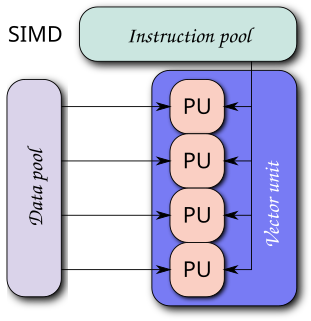Intel Ct is a programming model developed by Intel to ease the exploitation of its future multicore chips, as demonstrated by the Tera-Scale research program.
In computing, a parallel programming model is an abstraction of parallel computer architecture, with which it is convenient to express algorithms and their composition in programs. The value of a programming model can be judged on its generality: how well a range of different problems can be expressed for a variety of different architectures, and its performance: how efficiently the compiled programs can execute. The implementation of a parallel programming model can take the form of a library invoked from a sequential language, as an extension to an existing language, or as an entirely new language.

Intel Corporation is an American multinational corporation and technology company headquartered in Santa Clara, California, in the Silicon Valley. It is the world's second largest and second highest valued semiconductor chip manufacturer based on revenue after being overtaken by Samsung, and is the inventor of the x86 series of microprocessors, the processors found in most personal computers (PCs). Intel ranked No. 46 in the 2018 Fortune 500 list of the largest United States corporations by total revenue.

A multi-core processor is a single computing component with two or more independent processing units called cores, which read and execute program instructions. The instructions are ordinary CPU instructions but the single processor can run multiple instructions on separate cores at the same time, increasing overall speed for programs amenable to parallel computing. Manufacturers typically integrate the cores onto a single integrated circuit die or onto multiple dies in a single chip package. The microprocessors currently used in almost all personal computers are multi-core.
It is based on the exploitation of SIMD to produce automatically parallelized programs.

Single instruction, multiple data (SIMD) is a class of parallel computers in Flynn's taxonomy. It describes computers with multiple processing elements that perform the same operation on multiple data points simultaneously. Such machines exploit data level parallelism, but not concurrency: there are simultaneous (parallel) computations, but only a single process (instruction) at a given moment. SIMD is particularly applicable to common tasks such as adjusting the contrast in a digital image or adjusting the volume of digital audio. Most modern CPU designs include SIMD instructions to improve the performance of multimedia use. SIMD is not to be confused with SIMT, which utilizes threads.
On August 19, 2009, Intel [1] acquired RapidMind, a privately held company founded and headquartered in Waterloo, Ontario, Canada. RapidMind and Ct combined into a successor named Intel Array Building Blocks (ArBB) [2] [3] released in September 2010.
RapidMind Inc. was a privately held company founded and headquartered in Waterloo, Ontario, Canada, acquired by Intel in 2009. It provided a software product that aims to make it simpler for software developers to target multi-core processors and accelerators such as graphics processing units (GPUs).

Waterloo is a city in Ontario, Canada. It is the smallest of three cities in the Regional Municipality of Waterloo, and is adjacent to the city of Kitchener.

Canada is a country in the northern part of North America. Its ten provinces and three territories extend from the Atlantic to the Pacific and northward into the Arctic Ocean, covering 9.98 million square kilometres, making it the world's second-largest country by total area. Canada's southern border with the United States is the world's longest bi-national land border. Its capital is Ottawa, and its three largest metropolitan areas are Toronto, Montreal, and Vancouver. As a whole, Canada is sparsely populated, the majority of its land area being dominated by forest and tundra. Consequently, its population is highly urbanized, with over 80 percent of its inhabitants concentrated in large and medium-sized cities, many near the southern border. Canada's climate varies widely across its vast area, ranging from arctic weather in the north, to hot summers in the southern regions, with four distinct seasons.


